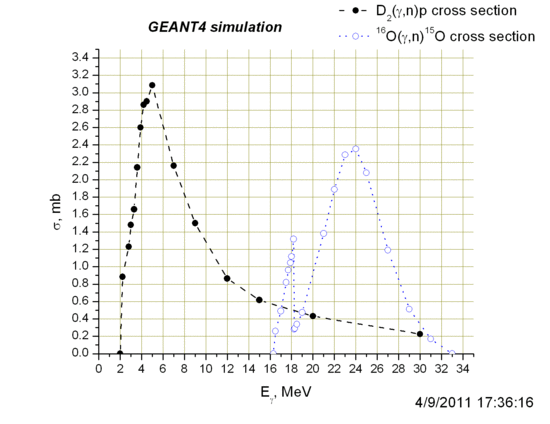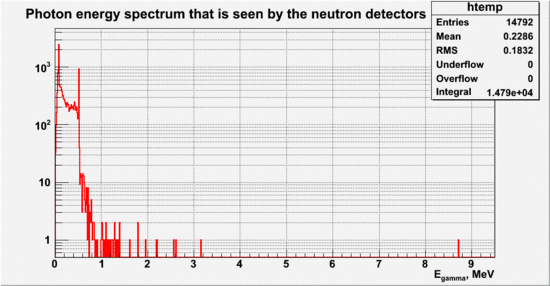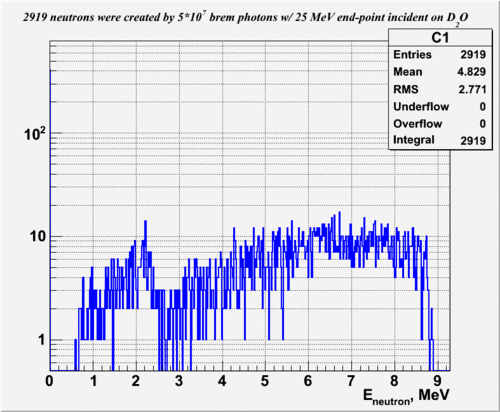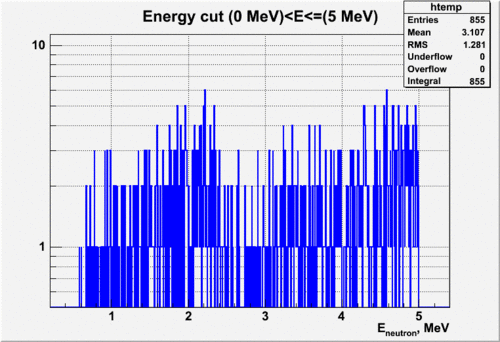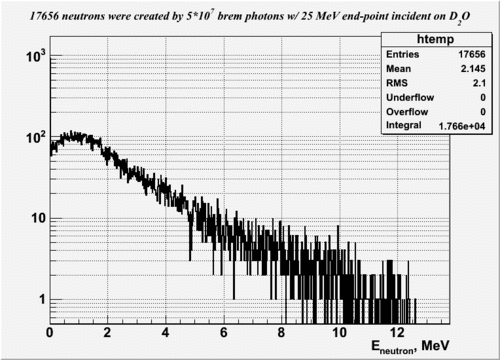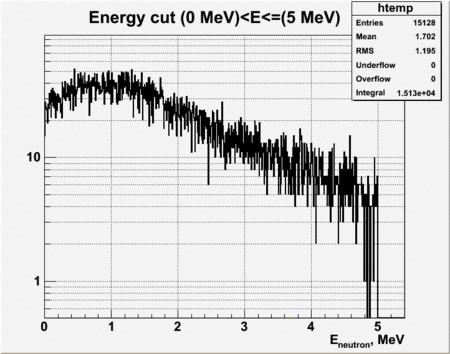Difference between revisions of "D2O photodisintegration simulation"
| (39 intermediate revisions by the same user not shown) | |||
| Line 2: | Line 2: | ||
[[File:dustin_anal.pdf]] | [[File:dustin_anal.pdf]] | ||
| + | |||
| + | ==<math>(\gamma,n)</math> reaction cross sections for different elements== | ||
| + | |||
The result of GEANT4 simulation of neutron photoproduction on deuterium and oxygen-16 is presented below: | The result of GEANT4 simulation of neutron photoproduction on deuterium and oxygen-16 is presented below: | ||
| − | [[File:X_section_compare.gif | | + | [[File:X_section_compare.gif | 550 px]] |
| + | |||
| + | Experimental cross section for <math>(\gamma,n)</math> reaction on Pb-208 taken from "Handbook on photonuclear data for applications. Cross-sections and spectra": | ||
| + | [[File:Pb208_gn_xsection.jpg | 550 px]] | ||
| + | |||
| + | We have to be really careful about placing lead shielding around the beam line. Scattered photons may produce background neutrons in the lead shielding of neutron detectors. | ||
| + | |||
| + | The simulation shows that enrgy spectrum of photons that is seen by our neutron detectors has the following shape (initial brem spectrum modified by the <math>D_2O</math> target): | ||
| + | |||
| + | [[File:Modified_brem.gif | 550 px]] | ||
| + | |||
| + | <math>10^6</math> brem photons were thrown on the target and as a detector it was used a ring surrounding the target with the transversal dimensions corresponding to the dimensions of the scintillator. The total number of counts in a single detector will be a small part of the number of counts presented on the plot. | ||
| + | |||
| + | Hence, it seems that there is no need to worry about neutrons produced in the lead shielding of our neutron detectors because we do not have many photons which are energetic enough to produce neutrons in the lead. | ||
| + | |||
| + | ==Neutron spectra separation== | ||
| + | |||
| + | Neutron yield (<math>4\pi</math>) from <math>D_2O</math> (90%<math>D_2</math> concentration) in reaction <math>O16(\gamma,n)O15</math> is presented below. Initially <math>5\cdot 10^7</math> brem photons with 25 MeV end-point energy were thrown on the target. 410 neutrons initially produced got absorbed in the target (E=0MeV) and 2509 neutrons will likely escape the target. Figure in blue on the left is the total energy spectrum of neutrons created in reaction <math>O16(\gamma,n)O15</math>. Figure in blue on the right is the neutron energy spectrum with energy cut applied. | ||
| + | |||
| + | [[File:O16_neutron_yield.gif | 500 px]] [[File:O16_neutron_yield_cut.gif | 500 px]] | ||
| + | |||
| + | Neutron yield (<math>4\pi</math>) from <math>D_2O</math> (90%<math>D_2</math> concentration) in reaction <math>D_2(\gamma,n)p</math> is presented below. Initially <math>5\cdot 10^7</math> brem photons with 25 MeV end-point energy were thrown on the target. 857 neutrons initially produced got absorbed in the target (E=0MeV) and 16799 neutrons will likely escape the target. Figure in black on the left is the total energy spectrum of neutrons created in reaction <math>D_2(\gamma,n)p</math>. Figure in blue on the right is the neutron energy spectrum with energy cut applied. | ||
| + | [[File:D2_neutron_yield2.gif | 500 px]] [[File:D2_neutron_yield_cut.gif | 450 px]] | ||
| − | + | So, if we apply the energy cut in neutron spectrum which is a sum of neutrons coming from <math>O16(\gamma,n)O15</math> and <math>D_2(\gamma,n)p</math> reactions at (0MeV)<E<=5MeV, then the ratio of "unpolarized" neutrons from <math>O16(\gamma,n)O15</math> and "polarized" neutrons from <math>D_2(\gamma,n)p</math> will be <math>855/15128=0.056</math>. In the same time we will loose <math>(16799-15128)/15128=11%</math> of the "good" high energy neutrons produced in <math>D_2(\gamma,n)p</math> reaction. Binning is the same for all the plots above. | |
| − | + | I will verify if those spectra and all the ratios are the same in the case where we use the geometrical constrains applied by the detectors placement. | |
Latest revision as of 15:12, 11 April 2011
reaction cross sections for different elements
The result of GEANT4 simulation of neutron photoproduction on deuterium and oxygen-16 is presented below:
Experimental cross section for reaction on Pb-208 taken from "Handbook on photonuclear data for applications. Cross-sections and spectra":
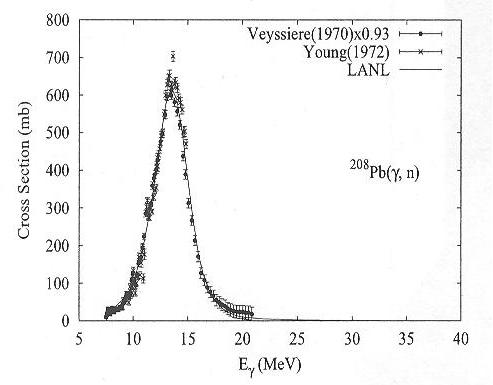
We have to be really careful about placing lead shielding around the beam line. Scattered photons may produce background neutrons in the lead shielding of neutron detectors.
The simulation shows that enrgy spectrum of photons that is seen by our neutron detectors has the following shape (initial brem spectrum modified by the target):
brem photons were thrown on the target and as a detector it was used a ring surrounding the target with the transversal dimensions corresponding to the dimensions of the scintillator. The total number of counts in a single detector will be a small part of the number of counts presented on the plot.
Hence, it seems that there is no need to worry about neutrons produced in the lead shielding of our neutron detectors because we do not have many photons which are energetic enough to produce neutrons in the lead.
Neutron spectra separation
Neutron yield () from (90% concentration) in reaction is presented below. Initially brem photons with 25 MeV end-point energy were thrown on the target. 410 neutrons initially produced got absorbed in the target (E=0MeV) and 2509 neutrons will likely escape the target. Figure in blue on the left is the total energy spectrum of neutrons created in reaction . Figure in blue on the right is the neutron energy spectrum with energy cut applied.
Neutron yield () from (90% concentration) in reaction is presented below. Initially brem photons with 25 MeV end-point energy were thrown on the target. 857 neutrons initially produced got absorbed in the target (E=0MeV) and 16799 neutrons will likely escape the target. Figure in black on the left is the total energy spectrum of neutrons created in reaction . Figure in blue on the right is the neutron energy spectrum with energy cut applied.
So, if we apply the energy cut in neutron spectrum which is a sum of neutrons coming from and reactions at (0MeV)<E<=5MeV, then the ratio of "unpolarized" neutrons from and "polarized" neutrons from will be . In the same time we will loose of the "good" high energy neutrons produced in reaction. Binning is the same for all the plots above.
I will verify if those spectra and all the ratios are the same in the case where we use the geometrical constrains applied by the detectors placement.
